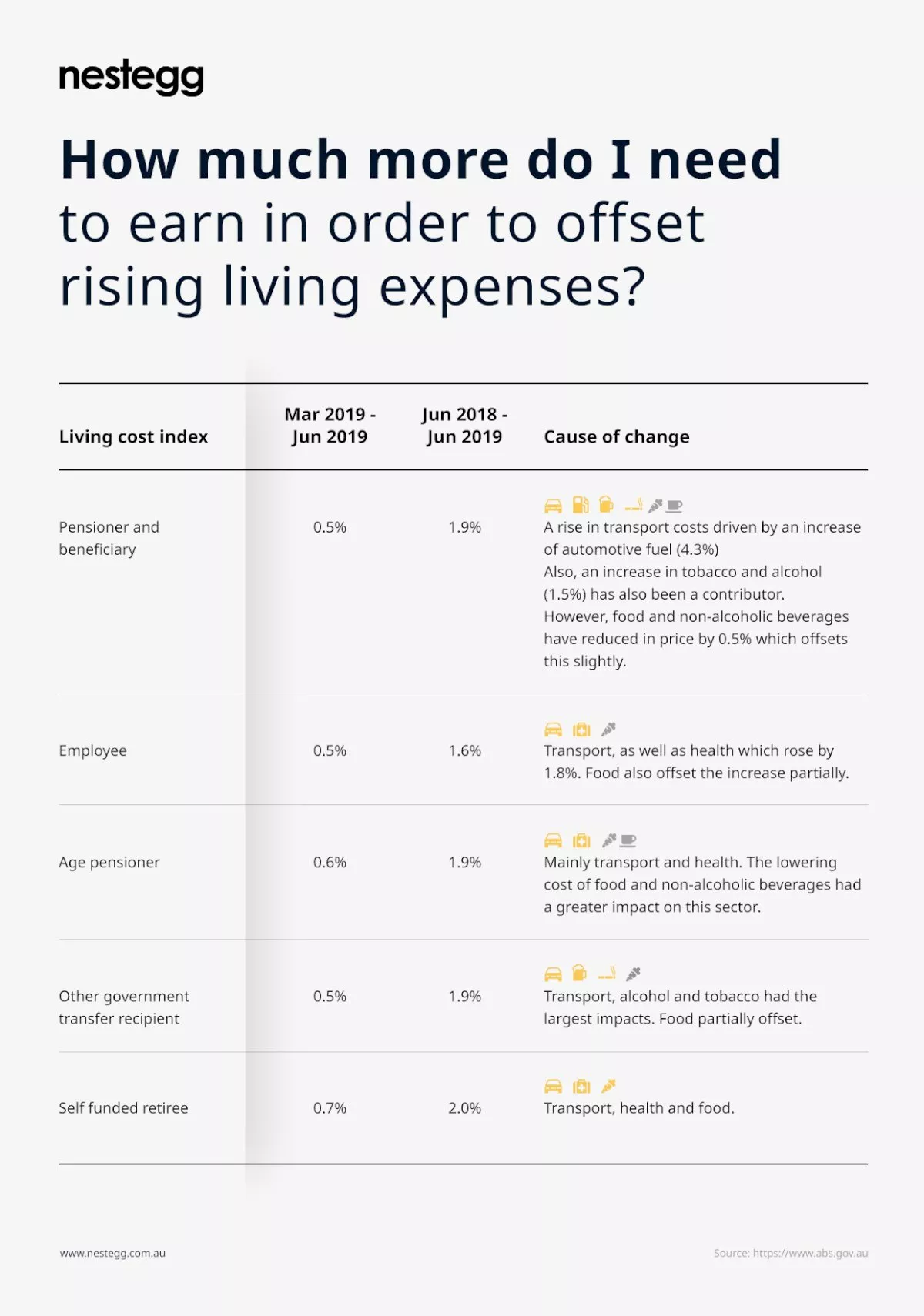Earn
How much more do I need to earn in order to offset rising living expenses
Earn
How much more do I need to earn in order to offset rising living expenses
Inflation erodes the value of a currency and increases the price of goods, making it harder to maintain your standard of living.

How much more do I need to earn in order to offset rising living expenses
Inflation erodes the value of a currency and increases the price of goods, making it harder to maintain your standard of living.


To maintain your lifestyle, your after-tax income needs to increase enough to offset the effects of inflation. This means if inflation is at 2.3 per cent, the increase you’ll need to maintain your current lifestyle should be a minimum of 2.3 per cent of your base pay.
To determine how much after-tax money Aussies need, the Australian Bureau of Statistics (ABS) regularly releases the Selected Living Cost Indexes (SLCI) report.
This report measures the impact of price changes on the amount of out-of-pocket expenses households use to purchase the same quality and quantity of goods and services.
According to the June 2019 SLCI report, the consumer price index (CPI) increased by 0.6 per cent in the quarter ending June 2019.
Between June 2018 and June 2019 indexes, the ABS revealed a 1.6 per cent increase.
This means that Aussies should have earned about 0.6 per cent more in after-tax income in the past quarter to be able to afford the same purchases as they would have in the previous quarter.
Likewise, the 1.6 per cent increase indicates that net income in the past financial year should have increased by 1.6 per cent in order to maintain the same lifestyle.
The SLCI report also reveals that self-funded retirees were most impacted by the rise in CPI as transport, health and food costs forced expenses to increase by 2 per cent in the past year.
This is followed by age pensioners whose transport and health expenses saw a price increase of 0.6 per cent in the March to June 2019 quarter. This puts their June 2018 to June 2019 cost of living increase at 1.9 per cent.
Pensioners and beneficiaries, as well as other government transfer recipients, were equally impacted by the increase in transport, alcohol and tobacco prices.
Both groups required a 0.5 per cent increase during the June 2019 quarter and 1.9 increase for the year.
Employed households were most affected by the rising cost of transport and health expenses. The March to June 2019 quarter recorded a 0.5 per cent increase, while the year ending June 2019 revealed a 1.9 per cent increase.
The decrease in food and non-alcoholic beverage prices partially offset the price increase of other commodities.
About the author

About the author


Salary
The financial benefits of a diversified income stream
In today’s volatile economic environment, relying solely on a single source of income can be risky. Diversifying your income streams can provide financial stability, reduce the risk of financial dow...Read more

Salary
Despite losing top spot, Elon Musk rakes in $400,000 hourly
Elon Musk, the entrepreneur known for his involvement in a wide range of innovative and technological businesses, has recently been dethroned as the wealthiest individual in the world, with Bernard Ar...Read more

Salary
Rising unemployment and skill shortages prompt Australian businesses to look globally for talent
Australia has witnessed its unemployment rate surging above 4% for the first time in two years, revealed by the latest Labour Force data. ...Read more

Salary
New findings link job mobility hurdles to stagnant wage growth
Recent research from the e61 Institute has unearthed significant links between slow wage growth in Australia and obstacles to job mobility, including non-compete clauses, complicated occupational lice...Read more

Salary
Employers scrambling to prevent workplace brain drain
As workplace managers face a swiftly evolving employment market that’s increasingly favouring the demands of white-collar employees and jobseekers, bosses are falling under mounting pressure to pres...Read more

Salary
Unions back Albanese’s pledge to close gender pay gap
An electoral promise from Labor to make gender pay equity an objective of the Fair Work Act has been hailed as a “watershed moment” from industry peak bodies who have traditionally advocated for s...Read more

Salary
Coles asked to disprove $115m in alleged wage theft
One of Australia’s biggest supermarkets faces allegations that it underpaid more than 7,500 employees a total of $115 million. ...Read more

Salary
Gen Z left behind in progress to gender equality
Women under 25 may emerge from the pandemic in a worse financial position than when it began, new research has shown. ...Read more

Salary
The financial benefits of a diversified income stream
In today’s volatile economic environment, relying solely on a single source of income can be risky. Diversifying your income streams can provide financial stability, reduce the risk of financial dow...Read more

Salary
Despite losing top spot, Elon Musk rakes in $400,000 hourly
Elon Musk, the entrepreneur known for his involvement in a wide range of innovative and technological businesses, has recently been dethroned as the wealthiest individual in the world, with Bernard Ar...Read more

Salary
Rising unemployment and skill shortages prompt Australian businesses to look globally for talent
Australia has witnessed its unemployment rate surging above 4% for the first time in two years, revealed by the latest Labour Force data. ...Read more

Salary
New findings link job mobility hurdles to stagnant wage growth
Recent research from the e61 Institute has unearthed significant links between slow wage growth in Australia and obstacles to job mobility, including non-compete clauses, complicated occupational lice...Read more

Salary
Employers scrambling to prevent workplace brain drain
As workplace managers face a swiftly evolving employment market that’s increasingly favouring the demands of white-collar employees and jobseekers, bosses are falling under mounting pressure to pres...Read more

Salary
Unions back Albanese’s pledge to close gender pay gap
An electoral promise from Labor to make gender pay equity an objective of the Fair Work Act has been hailed as a “watershed moment” from industry peak bodies who have traditionally advocated for s...Read more

Salary
Coles asked to disprove $115m in alleged wage theft
One of Australia’s biggest supermarkets faces allegations that it underpaid more than 7,500 employees a total of $115 million. ...Read more

Salary
Gen Z left behind in progress to gender equality
Women under 25 may emerge from the pandemic in a worse financial position than when it began, new research has shown. ...Read more







